The statuette is a small clay head, surrounded by hair made with a series of notches engraved at regular distances; the face is flat, with a slightly oblique profile and turned upwards from which the profile of the nose emerges. The eyes are marked by two horizontal incisions, while the mouth is represented by an isosceles triangle with the vertex facing downwards and inside it an incision crosses the vertex with a continuous line which continues up to the neck and ends with a tongue which it protrudes about 1 cm.; this way of representing the mouth, the triangle pointing downwards, in the Neolithic context depicts the regenerative vulva, found in various sepulchral monuments as well as on numerous anthropomorphic trays of the Aegean area, where associated with other symbols it represented the Goddess in her aspect of death and rebirth. Above the mouth, the nose and eyebrows together, the only anatomical details in relief on the face, form a single model with the so-called "T" pattern, synthesizing a bovine or taurine head, a rather frequent Neolithic symbology, both on Balkan ritual pottery and in the ceramics of the Serra d'Alto style, later widespread in the reliefs of bull heads of the Domus de Janas Sarde.
Both symbols, the vulva and the bull's head are symbols of regeneration, i.e. the immediate transformation from death to life, praising the theme of fertility and therefore the agricultural cult of these populations connected to the cycle of the seasons, of the harvests, of the moon, in the the only principle of the continuous regeneration of life. At present it is not easy to indicate with certainty the characteristics of these cults, only hypotheses can be made, just as it is not certain whether they were restricted to the family or to a wider community.
The back of the figurine is unfinished, has a rough surface and ends at the bottom with a rounded tongue, as if it were to be placed directly on the ground or on a non-found support, perhaps because it was made of perishable material.
Traces of red ocher have been identified on the inner right side of the hair, at the height of the neck, while traces of a whitish color are present on the face. Where the statuette was found, the surface was completely submerged in sea water, which probably had a devastating effect on the painted surfaces over time, contributing to the partial cancellation of the colours.
From a stylistic point of view, this statuette has no valid comparisons in Italy, while on a symbolic level it can refer to the ideological world of the Apulian-Materan agricultural communities of the second millennium; on the other hand, cultural influences come from the Balkan area of the Butmir circle, but with profound autochthonous connotations, such that the statuette appears to be original and unique in its kind.
Two pebbles painted in red ocher were also found in the cave, with abstract and geometric decorations spread only on one side of the pebble.
The first has a rhomboidal shape, flat on both faces, with a slight depression on the front and corresponding hump on the opposite side. It has dimensions of approximately 16,1 in height, 9,3 in width and 2 cm. thick; the whole plastic ensemble suggests the vision of a wider and stockier lower part and a more slender and pointed upper part. The pebble is entirely surrounded by a red band of about 1 cm. wide along the entire perimeter which becomes much thicker in the apical part, in the center of which there is a less colored oval. In correspondence with the maximum width of the pebble, 7 segments with a thickness of about 1 mm branch off towards the centre. and between 1 and 1,5 cm long. Other oblique lines can also be glimpsed, always directed towards the center of the pebble, but made less evident, perhaps because they were already less intensely colored at the origin or perhaps as a result of the poor state of conservation, given that the finds were submerged for a long time in the waterfall. The other pebble is oblong and has two flat faces, with the left side straight and the right side curved. It has the dimensions of 6,9 in height and 3,8 cm. wide; the red ocher decoration has 3 parallel and oblique bands, placed at the point of maximum width of the pebble such as to divide it into two sections. 13 orthogonal lines start from this band, extending upwards and downwards following the natural shape of the stone. In fact, near the ends, the lines tend to widen giving the effect of a sunburst.
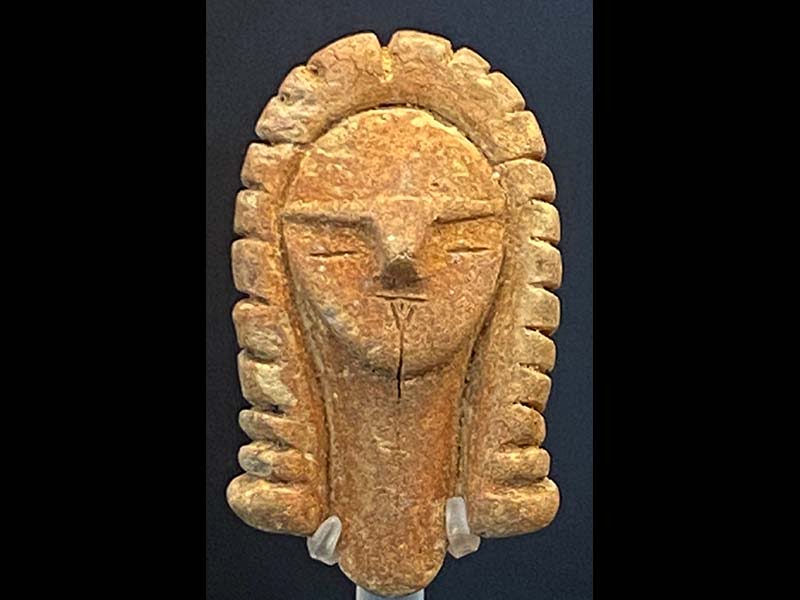
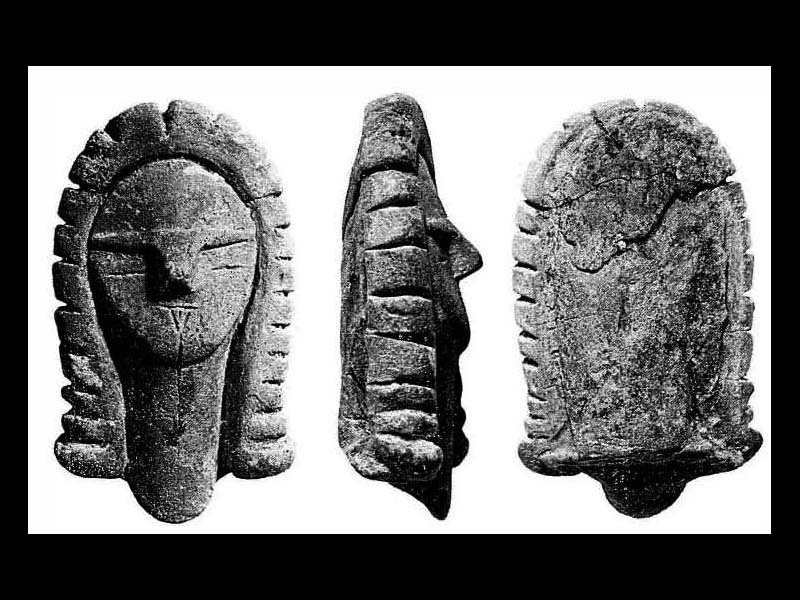
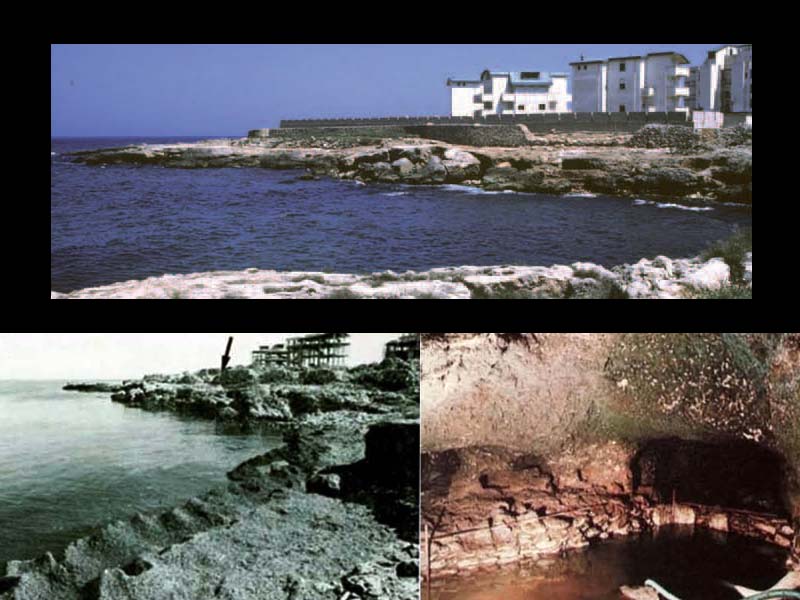
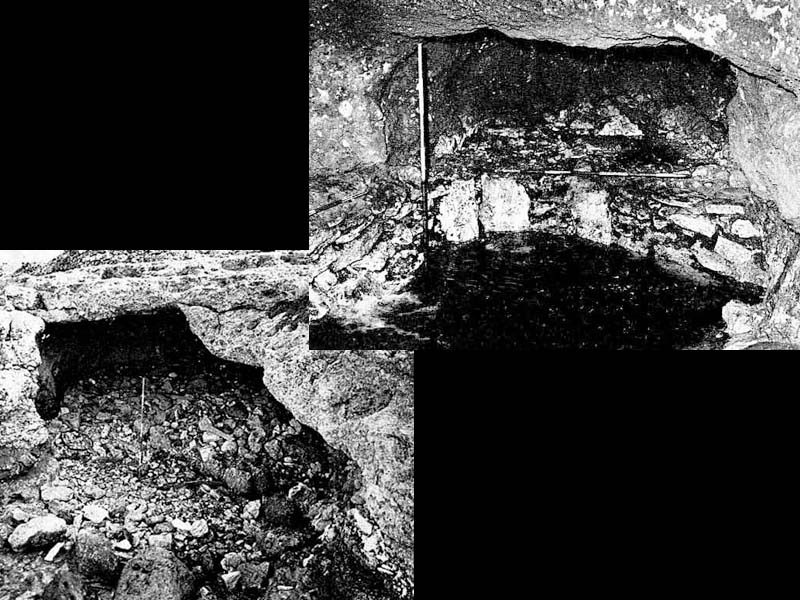
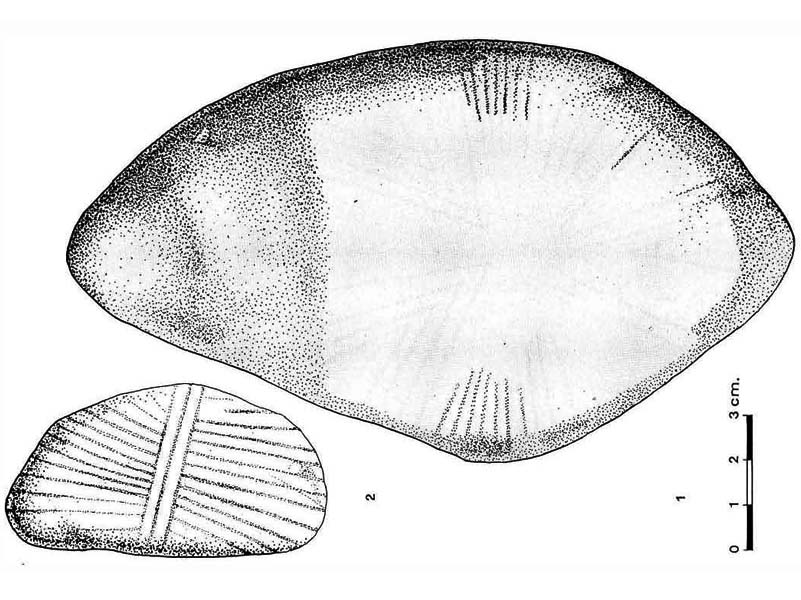
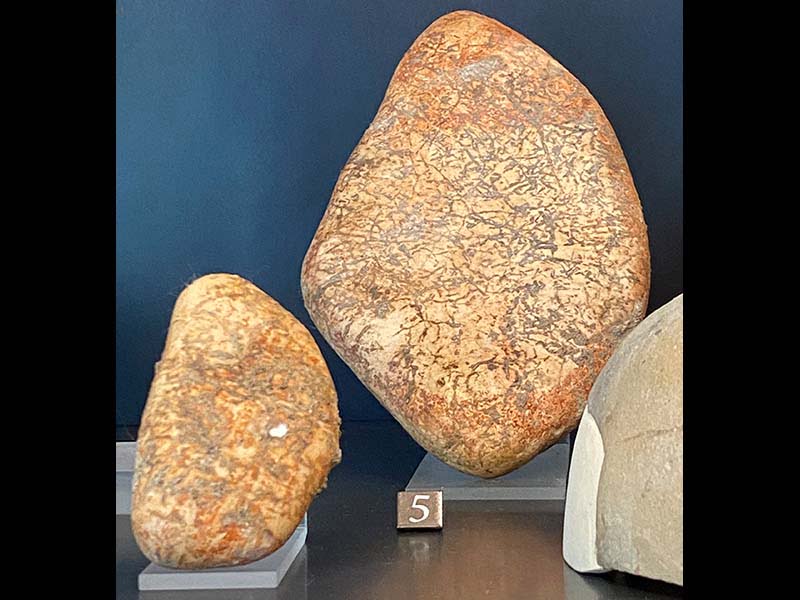
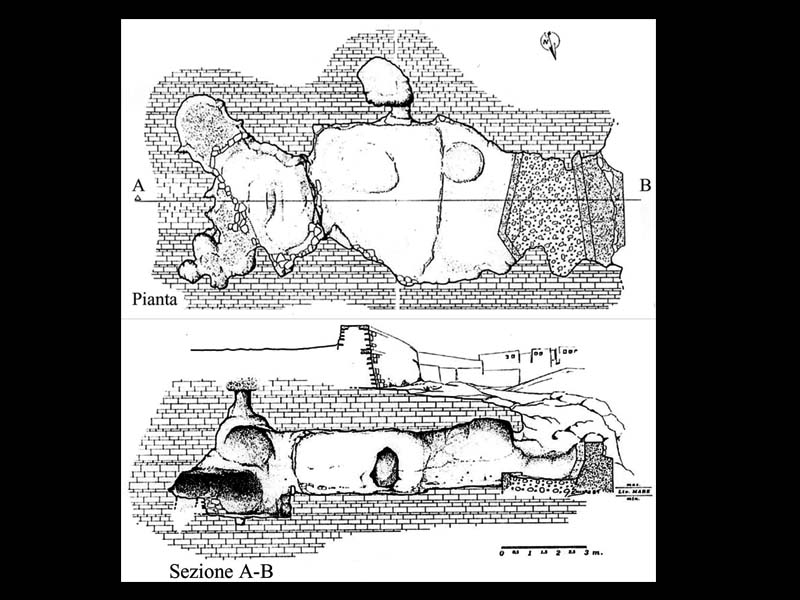
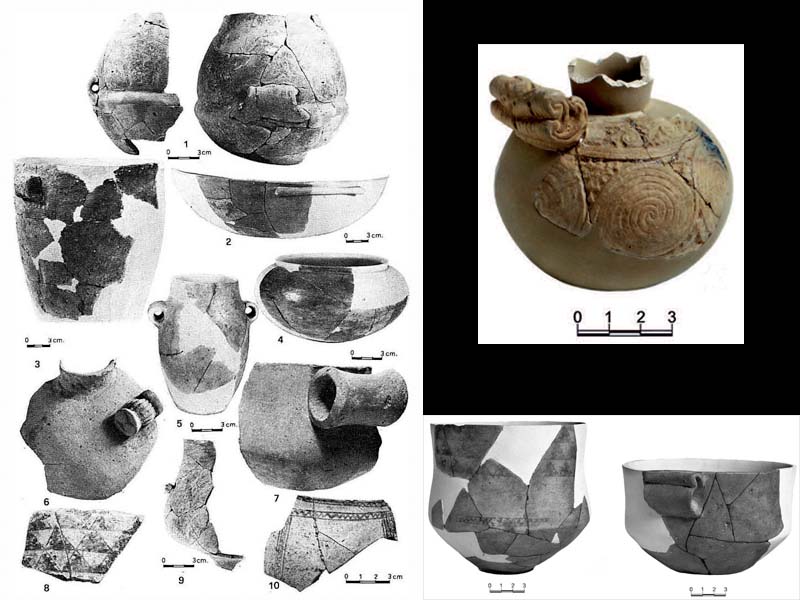
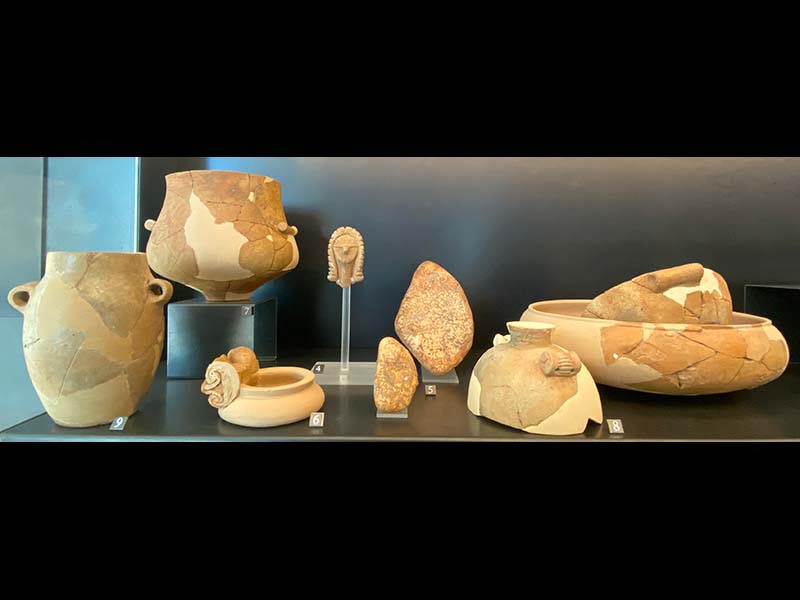
Historical notes
The statuette was found by prof. Francesco Biancofiore during the excavation campaigns conducted between 1975 and 1977 in the Grotta di Cala Scizzo, a semi-artificial cavity 16 meters long and about 7 meters wide in the central area; it consists of a main quadrangular room, a small ellipsoidal hypogeum room located on the right side which is accessed via a narrower lane and a terminal retro-grotto placed at a level about 1 meter lower, with two side branches. The mouth of the cave coincides with the shoreline, therefore during the excavations it was necessary to build a system of dams, still existing on site, in order to suck up the water that covered the entire surface. In the central part of the cave a stratigraphic profile was extrapolated with the identification of two clearly distinct parts divided by a sterile layer, of which the lower section, level I, is dated between the middle advanced Neolithic and the final Neolithic, with materials pottery ascribable to the Serra d'Alto phase (from the homonymous site in the province of Matera which gave its name to the cultural facies, characterized by a specific complex ornamentation with painted, plastic or engraved spirals and meanders) and to the final phase Diana – Bellavista ( with a simpler ornamentation, painted in monochrome red or with engraved spiral motifs), while level II is placed exclusively in the final Neolithic, with materials of the Diana-Bellavista type; the last level, layer III, is instead dated to the Eneolithic, characterized by the inclusion of two human burials.
The small hypogeum located to the right of the central cavity and the back cave also belonged to level I of the stratigraphic sequence.
During the excavation investigations it was possible to ascertain a different use of the various rooms of the cave: while the part in front was frequented for a long period of time, with the presence of walking surfaces and large hearths also used discontinuously and resumed, the back cave instead was used as a sacred area, divided from the front part by a stone enclosure also made up of some limestone slabs similar to steles, mortared with reddish clay and driven into the ground. Two of these steles were near the entrance to the enclosure, leaning outwards with a large quantity of scattered broken millstones next to them, worn down by use and, below one of these, the largest painted pebble was found and, not far away, the smallest painted pebble was found in the central compartment. In another portion of the enclosure, near the south-eastern corner, there were three other flat stelae, rectangular in shape, at the base of which the statuette was placed. The circumstances of the discovery have led to think of the possible attestation of a propitiatory ritual linked to agriculture, to which the millstones and the remains of offerings of wheat and barley, widely scattered inside the cave, also refer. The rituals pertaining to the spiritual world are always connected with the binomial fecundity-fertility expressed both in the representation of the essential features of the statuette's face and schematically engraved on the body of the vases. As part of the archaeological activities, the direction of the excavation was entrusted to Alfredo Geniola, while the stratigraphic survey to professor Donato Coppola.
CARD
LATEST PUBLISHED TEXTS
VISIT THE FACTSHEETS BY OBJECT

